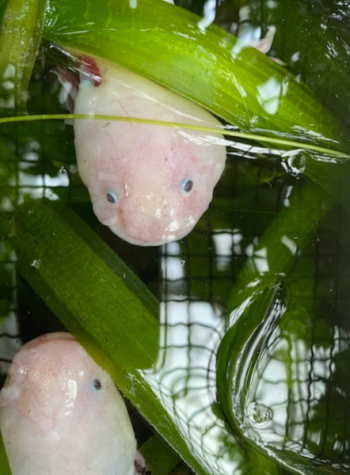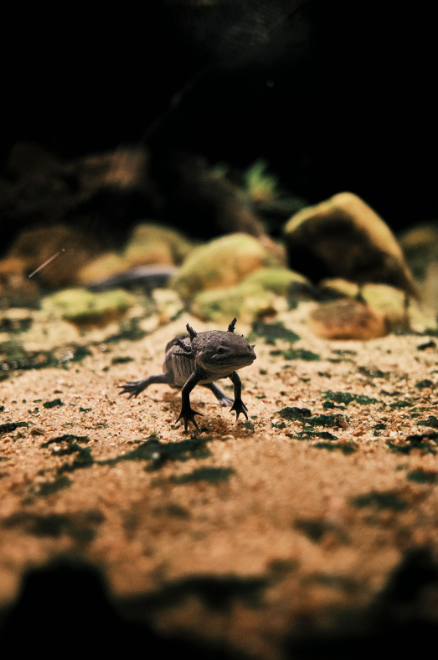The Rise and Fall of the Amphibian, the Axolotl
The axolotl has recently been popularized through the media because of the increasing urgency of their extinction in the wild. This rise in awareness, however, has also popularized the animal as an exotic pet, leveraging the unethical breeding that continues to circulate the pet industry.
Axolotl can be roughly translated to ‘water-dog’ (most commonly), ‘water-monstrosity,’ or ‘water-twin.’ The terms, in their respective ways, are associated with the god Xolotl.
Recognized in the media for their permanent smile, axolotls have recently taken over the internet to the point where many instantly recognize them. A few years ago, I might have had a faint recollection of the animal from an exhibit at a museum; today, however, I can associate it with Pokemon and Instagram reels on “How to Build your Axolotl a Realistic Habitat.”
The axolotl (Ambystoma mexicanum) is native only to Lake Xochimilco in Mexico and is most commonly dark brown in color. The most popular variation is the pink-skinned leucistic (reduced pigmentation) axolotl – ironically one of the rarest variations in the wild and the most common in captivity.
I first heard of axolotls on a school trip to the American Museum of Natural History in New York City, many years ago. The museum’s ‘Life at the Limits’ exhibition zoomed in on the evolution of ‘strange’ creatures such as the tardigrade, mantis shrimp, corpse flower, and the axolotl. After the exhibition, I had forgotten the name of the animal immediately, and its image fled my mind completely until I was reacquainted with the creature a few years later.
Growing Popularity
The axolotl species has been gaining popularity through TikTok videos and Minecraft, featuring their youthful appearance that continues to draw people in. But, the spotlight that is kept on the axolotl by the media – has also increased sales.
In an interview conducted by Daniel Pink, bestselling author of Drive and To Sell is Human, Derek Thompson, staff writer at The Atlantic and writer of Hit Makers (2017), said that for something to become popular, it needs to be an “interplay between originality and familiarity… and between greatness and serendipity.” When we think about axolotls as a commodity that can be consumed and popularized, we realize that it ticks off all of the boxes.
Thompson said most consumers are simultaneously neophilic – curious to discover new things – and neophobic – afraid of anything too new. The allure of the axolotl is mainly attributed to its appearance since the amphibian is decorated with a friendly demeanor and feathered gills that resemble alien-like features from television shows and movies that you may have watched throughout your life. This familiarity is attractive to many consumers, especially when it is both something they have and have not seen before.
In Thompson’s book, Hit Makers, he touched on the influence of a broadcast. Once an influential person or organization advocates for something, it is then recognized by a large group of people that buy into it and, altogether, make it popular. Mojang, the video game developer for Minecraft, included axolotls in the game for the ‘Caves & Cliffs 1.17’ update in June 2021 to shed light on the endangered species. In the game, they can be tamed and taken as pets that come in a multitude of colors that vary from yellow to blue, a variation that does not actually exist. As intended, the launch of the Minecraft update triggered a new trend on the online scene. Bronx Science student Allison Chau ’25 said, “I only know about axolotls from Minecraft.”
Axolotls were first marketed as an easy-to-care-for exotic species for everyday people to raise. Although media popularity has raised awareness of axolotl endangerment, it is the axolotl’s cute appearance that has facilitated the ongoing trend. But, unfortunately, trends come and go. Given this pattern, some who have lived up to the trend of housing an axolotl as a pet do not take into account the commitment that goes beyond a few videos. The incredible demand for the species following its ‘broadcast,’ however, impacts how they are bred and sold.

Breeding in Captivity
There are now one million axolotls in captivity, including those used as lab specimens. In 1864, 34 axolotls were shipped to France from Lake Xochimilco for modern research; from this group of less than three dozen came the breeding of thousands – many of the axolotls currently in captivity are descendants of the original 34.
As a result of the growing appeal of axolotls, millions of individuals are kept in captivity to be sold as pets and entertainment in small aquariums. To keep up with great demand, axolotls are often bred to produce animals with harmful or desirable physical and genetic traits resulting in a multitude of health issues. Axolotls are often accidentally bred in captivity from packed tanks; unfortunately, some breeders will intentionally inbreed them to achieve specific genetic features. Many of these captive animals will tend to have much weaker immune systems.
The animals are frequently held in overstocked tanks with a lack of filtration or temperature-regulating systems, subjecting the axolotls to stress-inducing conditions. They can often be found underfed and with injuries from nipping cohabitants and gravel substrate, which can be easily ingested and result in intestinal blockage.
The Past and Present of Lake Xochimilco
The name ‘axolotl’ originated in 13th-century Mexico City under Aztec mythology and the Nahuatl language after the God of fire and lighting, Xolotl. Xolotl had surveillance over death and resurrection, games, monstrous beings, and twins; Xolotl is considered the ‘canine twin’ of Quetzalcoatl – one of the most revered Aztec gods – who is associated with knowledge and learning. In an attempt to avoid banishment from the Earth and avoid sacrifice, Xolotl disguised himself as a dog-like creature, the axolotl.
The axolotl, in appearance, is very reminiscent of Aztec art, described similarly to statues of Aztec gods as ‘stony’ with unclosing ‘eyes of gold,’ no lids, and a face reminiscent of a dog, again pertaining to the god Xolotl.
Axolotls had once thrived in chinampas – an agricultural system of artificial floating islands used by the Aztec peoples between the 14th and 16th centuries – and canals when they were used by indigenous Mexica for food and medicine. Spanish invasion and colonization stunted environmental growth and changed traditional agricultural methods, thus decreasing the axolotl’s natural habitat. Many farmers continue to use harmful fertilizers and pesticides that runoff into the canals and contaminate waters, making it unsafe and therefore impossible for its original inhabitants to remain.
For over a decade now, Mexican scientists have been working hand in hand with farmers to rebuild the axolotl population in Xochimilco. Axolotls serve as an indicator species in the environment; if axolotls are not present, it indicates that the water is contaminated. An absence of axolotls also, however, indicates to the people buying the crops from these farmers that the water is polluted. Farmers that choose to abandon their farms in response are replaced by people who will oftentimes dump more chemicals and sewage into the water, encouraging an axolotl-resistant habitant.
The axolotl’s rising popularity in the media raises awareness of the crippling ecosystem in their place of origin. More is being done to improve the conditions of the water of Xochimilco to revive both the axolotl population and the farms. If axolotls were to go extinct, it is possible that these efforts will be undone.
For over a decade now, Mexican scientists have been working hand in hand with farmers to rebuild the axolotl population in Xochimilco. Axolotls serve as an indicator species in the environment; if axolotls are not present, it indicates that the water is contaminated
Tori Wee is currently a Features Editor for ‘The Science Survey.’ Tori finds that journalism is a means to creatively educate others through in-depth...











